Estimation of Sediment Yield Change in a Loess Plateau Basin, China
Abstract
:1. Introduction
2. Materials and Methods
2.1. Study Watershed
2.2. Modeling Approach
2.2.1. The SWAT Model
2.2.2. Hydrologic Modelling
2.2.3. Suspended Sediment Modelling
2.3. SWAT Input Data
2.4. Model Calibration and Validation
2.5. Model Evaluation
2.6. Sensitivity Analysis
2.7. Scenario Analysis
- Scenario 0 (S0): climate data from 1979 to 1990 and land use of 1986.
- Scenario 1 (S1): climate data from 1979 to 1990 and land use of 2012.
- Scenario 2 (S2): climate data from 2001 to 2012 and land use of 2012.
3. Results and Discussions
3.1. Watershed Characteristics
3.2. Evaluation of the Streamflow Simulation
3.3. Sensitivity Analysis of Sediment Parameters
3.4. Evaluation of Sediment Load Simulation
3.5. Spatial Distribution of Soil Loss under Different Land Use Scenarios
3.5.1. Sediment Yield under Scenario 0
3.5.2. Sediment Yield under Scenario 1
3.5.3. Impact of Land Use Change on Spatial Sediment Yield Distribution
3.6. Spatial Distribution of Sediment Yield under Different Climate Scenarios
4. Conclusions
- The simulation results showed that both the land use change and climate change in these years led to the decrease in sediment yield.
- The extreme and severe erosion mostly occurred in the hilly area.
- Forest land and terraces are confirmed to have a better effect on erosion reduction in this area.
- Long-term traditional tillage will weaken the soil anti-erosion capability of land, leading to higher soil erosion. Forest, on the other hand, can improve the soil structure, enhance the soil anti-erosion capability, and have a large positive effect on soil conservation.
- Acting as the major influencing factor, land use change caused about 64.9% of the sediment yield reduction in the USK basin.
Acknowledgments
Author Contributions
Conflicts of Interest
References
- Sun, W.; Shao, Q.; Liu, J. Soil erosion and its response to the changes of precipitation and vegetation cover on the loess plateau. J. Geogr. Sci. 2013, 23, 1091–1106. [Google Scholar] [CrossRef]
- Kang, S.; Zhang, L.; Song, X.; Zhang, S.; Liu, X.; Liang, Y.; Zheng, S. Runoff and sediment loss responses to rainfall and land use in two agricultural catchments on the loess plateau of china. Hydrol. Process. 2001, 15, 977–988. [Google Scholar] [CrossRef]
- Liu, L.; Liu, X.H. Sensitivity analysis of soil erosion in the northern loess plateau. Procedia Environ. Sci. 2010, 2, 134–148. [Google Scholar] [CrossRef]
- Mosbahi, M.; Benabdallah, S.; Boussema, M.R. Assessment of soil erosion risk using swat model. Arab. J. Geosci. 2012, 6, 4011–4019. [Google Scholar] [CrossRef]
- Sun, W.; Shao, Q.; Liu, J.; Zhai, J. Assessing the effects of land use and topography on soil erosion on the loess plateau in china. Catena 2014, 121, 151–163. [Google Scholar] [CrossRef]
- Ouyang, W.; Hao, F.; Skidmore, A.K.; Toxopeus, A.G. Soil erosion and sediment yield and their relationships with vegetation cover in upper stream of the yellow river. Sci. Total Environ. 2010, 409, 396–403. [Google Scholar] [CrossRef] [PubMed]
- Li, C.; Qi, J.; Feng, Z.; Yin, R.; Guo, B.; Zhang, F.; Zou, S. Quantifying the effect of ecological restoration on soil erosion in china’s loess plateau region: An application of the mmf approach. Environ. Manag. 2010, 45, 476–487. [Google Scholar] [CrossRef] [PubMed]
- Lal, R. Soil degradation by erosion. Land Degrad. Dev. 2001, 12, 519–539. [Google Scholar] [CrossRef]
- Jain, M.K.; Das, D. Estimation of sediment yield and areas of soil erosion and deposition for watershed prioritization using gis and remote sensing. Water Resour. Manag. 2009, 24, 2091–2112. [Google Scholar] [CrossRef]
- Bieger, K.; Hormann, G.; Fohrer, N. Simulation of streamflow and sediment with the soil and water assessment tool in a data scarce catchment in the three gorges region, china. J. Environ. Qual. 2014, 43, 37–45. [Google Scholar] [CrossRef] [PubMed]
- Chen, L.; Huang, Z.; Gong, J.; Fu, B.; Huang, Y. The effect of land cover/vegetation on soil water dynamic in the hilly area of the loess plateau, china. Catena 2007, 70, 200–208. [Google Scholar] [CrossRef]
- Fu, B.; Zhao, W.; Chen, L.; Zhang, Q.; Lü, Y.; Gulinck, H.; Poesen, J. Assessment of soil erosion at large watershed scale using rusle and gis: A case study in the loess plateau of china. Land Degrad. Dev. 2005, 16, 73–85. [Google Scholar] [CrossRef]
- Tripathi, M.P.; Panda, R.K.; Raghuwanshi, N.S. Identification and prioritisation of critical sub-watersheds for soil conservation management using the swat model. Biosyst. Eng. 2003, 85, 365–379. [Google Scholar] [CrossRef]
- Sutherland, R.A.; Ziegler, A.D. Effectiveness of coir-based rolled erosion control systems in reducing sediment transport from hillslopes. Appl. Geogr. 2007, 27, 150–164. [Google Scholar] [CrossRef]
- Marques, M.J.; Bienes, R.; Jimenez, L.; Perez-Rodriguez, R. Effect of vegetal cover on runoff and soil erosion under light intensity events. Rainfall simulation over usle plots. Sci. Total Environ. 2007, 378, 161–165. [Google Scholar] [CrossRef] [PubMed]
- Croke, J.; Nethery, M. Modelling runoff and soil erosion in logged forests: Scope and application of some existing models. Catena 2006, 67, 35–49. [Google Scholar] [CrossRef]
- Koiter, A.J.; Owens, P.N.; Petticrew, E.L.; Lobb, D.A. The role of soil surface properties on the particle size and carbon selectivity of interrill erosion in agricultural landscapes. Catena 2017, 153, 194–206. [Google Scholar] [CrossRef]
- Sadeghi, S.H.R.; Sharifi Moghadam, E.; Khaledi Darvishan, A. Effects of subsequent rainfall events on runoff and soil erosion components from small plots treated by vinasse. Catena 2016, 138, 1–12. [Google Scholar] [CrossRef]
- Wen, L.; Zheng, F.; Shen, H.; Bian, F.; Jiang, Y. Rainfall intensity and inflow rate effects on hillslope soil erosion in the mollisol region of northeast china. Nat. Hazards 2015, 79, 381–395. [Google Scholar] [CrossRef]
- Jiang, C.; Chen, A.F.; Yu, X.Y.; Wang, F.; Mu, X.M.; Li, R. Variation of wind erosivity in the wind erosion and wing-water erosion regions in the loess plateau. Arid Zone Res. 2013, 30, 477–484. [Google Scholar]
- Li, Q.Y.; Cai, Q.G.; Fang, H.Y. Spatial characteristic research on wind erosion contribution to sediment yield in wind and water complex erosion zone of loess plateau. J. Water Res. Water Eng. 2007, 27, 552–557. [Google Scholar]
- Yang, H.; Wang, G.; Jiang, H.; Fang, H.; Ishidaira, H. Integrated modeling approach to the response of soil erosion and sediment export to land-use change at the basin scale. J. Hydrol. Eng. 2015, 20, C4014003-4014001–C4014003-4014013. [Google Scholar] [CrossRef]
- Kosmas, C. The effect of land use on runoff and soil erosion rates under mediterranean conditions. Catena 1997, 29, 45–59. [Google Scholar] [CrossRef]
- Thornes, J.B. The interaction of erosional and vegetational dynamics in land degradation: Spatial outcomes. In Vegetation and Erosion Processes Environment; Thornes, J.B., Ed.; John Wiley and Sons: Chichester, UK, 1990; pp. 41–53. [Google Scholar]
- Zhang, L.; Wang, J.; Bai, Z.; Lv, C. Effects of vegetation on runoff and soil erosion on reclaimed land in an opencast coal-mine dump in a loess area. Catena 2015, 128, 44–53. [Google Scholar] [CrossRef]
- Gupta, S.; Kumar, S. Simulating climate change impact on soil erosion using rusle model—A case study in a watershed of mid-himalayan landscape. J. Earth Syst. Sci. 2017, 126, 1–20. [Google Scholar] [CrossRef]
- Zhang, L.; Bai, K.Z.; Wang, M.J.; Karthikeyan, R. Basin-scale spatial soil erosion variability: Pingshuo opencast mine site in shanxi province, loess plateau of china. Nat. Hazards 2016, 80, 1213–1230. [Google Scholar] [CrossRef]
- Delgado, M.E.M.; Canters, F. Modeling the impacts of agroforestry systems on the spatial patterns of soil erosion risk in three catchments of claveria, the philippines. Agroforest. Syst. 2011, 85, 411–423. [Google Scholar] [CrossRef]
- Gassman, P.W. The soil and water assessment tool: Historical development, applications, and future research directions. Trans. ASAE 2007, 50, 1211–1250. [Google Scholar] [CrossRef]
- Arnold, J.G.; Srinivasan, R.; Muttiah, R.S.; Williams, J.R. Large area hydrologic modeling and assessment part i: Model development. J. Am. Water Resour. Assoc. 1998, 34, 73–89. [Google Scholar] [CrossRef]
- Arnold, J.G.; Fohrer, N. Swat2000: Current capabilities and research opportunities in applied watershed modelling. Hydrol. Process. 2005, 19, 563–572. [Google Scholar] [CrossRef]
- Qiu, L.J.; Zheng, F.L.; Yin, R.S. Swat-based runoff and sediment simulation in a small watershed, the loessial hilly-gullied region of china: Capabilities and challenges. Int. J. Sediment Res. 2012, 27, 226–234. [Google Scholar] [CrossRef]
- Wu, Y.; Chen, J. Modeling of soil erosion and sediment transport in the East River Basin in Southern China. Sci. Total Environ. 2012, 441, 159–168. [Google Scholar] [CrossRef] [PubMed]
- Shen, Z.Y.; Gong, Y.W.; Li, Y.H.; Hong, Q.; Xu, L.; Liu, R.M. A comparison of wepp and swat for modeling soil erosion of the zhangjiachong watershed in the three gorges reservoir area. Agric. Water Manag. 2009, 96, 1435–1442. [Google Scholar] [CrossRef]
- Changnon, S.A.; Demissie, M. Detection of changes in streamflow and floods resulting from climate fluctuations and land use drainage changes. Clim. Chang. 1996, 32, 411–421. [Google Scholar] [CrossRef]
- Zhao, Z.; Shahrour, I.; Bai, Z.; Fan, W.; Feng, L.; Li, H. Soils development in opencast coal mine spoils reclaimed for 1–13 years in the west-northern loess plateau of china. Eur. J. Soil Biol. 2013, 55, 40–46. [Google Scholar] [CrossRef]
- Zhang, Y. River characteristics and hydrologic analysis of sanggan river. Shanxi Hydrotech. 2003, 147, 36–38. [Google Scholar]
- Neitsch, S.L.; Williams, J.; Arnold, J.; Kiniry, J. Soil and Water Assessment Tool Theoretical Documentation Version 2009; Texas Water Resources Institute: College Station, TX, USA, 2011. [Google Scholar]
- Williams, J.R. Flood routing with variable travel time or variable storage coefficients. Trans. ASAE 1969, 12, 100–103. [Google Scholar] [CrossRef]
- Kim, N.W.; Lee, J. Enhancement of the channel routing module in SWAT. Hydrol. Process. 2009, 96–107. [Google Scholar] [CrossRef]
- Williams, J.R. Sediment routing for agricultural watersheds. J. Am. Water Resour. Assoc. 1975, 11, 965–974. [Google Scholar] [CrossRef]
- Wischmeier, W.H.; Simth, D.D. Predicting Rainfall-Erosion Losses from Cropland East of the Rocky Mountains: Guide for Selection of Practices for Soil and Water Conservation; Agriculture Handbook No. 282; U.S. Department of Agriculture: Washington, DC, USA, 1965.
- Neupane, R.P.; White, J.D.; Alexander, S.E. Projected hydrologic changes in monsoon-dominated himalaya mountain basins with changing climate and deforestation. J. Hydrol. 2015, 525, 216–230. [Google Scholar] [CrossRef]
- Gassman, P.W.; Reyes, M.R.; Green, C.H.; Arnold, J.G. Swat Peer-Reviewed Literature: A Review. In Proceedings of the 3rd International SWAT Conference, Zurich, Switzerland, 13–15 July 2005. [Google Scholar]
- Abbaspour, K.C.; Yang, J.; Maximov, I.; Siber, R.; Bogner, K.; Mieleitner, J.; Zobrist, J.; Srinivasan, R. Modelling hydrology and water quality in the pre-alpine/alpine thur watershed using SWAT. J. Hydrol. 2007, 333, 413–430. [Google Scholar] [CrossRef]
- Abbaspour, K. SWAT-CUP 2012: SWAT Calibration and Uncertainty Programs-A User Manual. Sci. Technol. 2014, 106. [Google Scholar]
- Nash, J.E.; Sutcliffe, J.V. River flow forecasting through conceptual models part i: A discussion of principles. J. Hydrol. 1970, 10, 282–290. [Google Scholar] [CrossRef]
- Yu, M.; Chen, X.; Li, L.; Bao, A.; Paix, M.J.D.L. Streamflow simulation by swat using different precipitation sources in large arid basins with scarce raingauges. Water Resour. Manag. 2011, 25, 2669–2681. [Google Scholar] [CrossRef]
- Krause, P.; Boyle, D.; Bäse, F. Comparison of different efficiency criteria for hydrological model assessment. Adv. Geosci. 2005, 5, 89–97. [Google Scholar] [CrossRef]
- Xu, Z.X.; Pang, J.P.; Liu, C.M.; Li, J.Y. Assessment of runoff and sediment yield in the miyun reservoir catchment by using swat model. Hydrol. Process. 2009, 23, 3619–3630. [Google Scholar] [CrossRef]
- Zhang, A.; Zhang, C.; Fu, G.; Wang, B.; Bao, Z.; Zheng, H. Assessments of impacts of climate change and human activities on runoff with swat for the huifa river basin, northeast china. Water Resour. Manag. 2012, 26, 2199–2217. [Google Scholar] [CrossRef]
- Ghaffari, G.; Keesstra, S.; Ghodousi, J.; Ahmadi, H. Swat-simulated hydrological impact of land-use change in the zanjanrood basin, northwest iran. Hydrol. Process. 2010, 24, 892–903. [Google Scholar] [CrossRef]
- Choi, J.Y.; Engel, B.A.; Chung, H.W. Daily streamflow modelling and assessment based on the curve-number technique. Hydrol. Process. 2002, 16, 3131–3150. [Google Scholar] [CrossRef]
- Kim, N.W.; Lee, J. Temporally weighted average curve number method for daily runoff simulation. Hydrol. Process. 2008, 22, 4936–4948. [Google Scholar] [CrossRef]
- Oeurng, C.; Sauvage, S.; Sánchez-Pérez, J.-M. Assessment of hydrology, sediment and particulate organic carbon yield in a large agricultural catchment using the swat model. J. Hydrol. 2011, 401, 145–153. [Google Scholar] [CrossRef] [Green Version]
- Betrie, G.D.; Mohamed, Y.A.; van Griensven, A.; Srinivasan, R. Sediment management modelling in the blue nile basin using swat model. Hydrol. Earth Syst. Sci. 2011, 15, 807–818. [Google Scholar] [CrossRef]
- Arabi, M.; Frankenberger, J.R.; Engel, B.A.; Arnold, J.G. Representation of agricultural conservation practices with swat. Hydrol. Process. 2008, 22, 3042–3055. [Google Scholar] [CrossRef]
- Tibebe, D.; Bewket, W. Surface runoff and soil erosion estimation using the swat model in the keleta watershed, ethiopia. Land Degrad. Dev. 2011, 22, 551–564. [Google Scholar] [CrossRef]
- Cao, W.; Bowden, W.B.; Davie, T.; Fenemor, A. Multi-variable and multi-site calibration and validation of swat in a large mountainous catchment with high spatial variability. Hydrol. Process. 2006, 20, 1057–1073. [Google Scholar] [CrossRef]
- Benaman, J.; Shoemaker, C.A.; Haith, D.A. Calibration and validation of soil and water assessment tool on an agricultural watershed in upstate new york. J. Hydrol. Eng. 2005, 10, 363–374. [Google Scholar] [CrossRef]
- Wang, J.Z. Influence of protective farming on soil water of wheat field. Sci.Soil Water Conserv. 2007, 5, 71–74. [Google Scholar]
- Chen, Y.; Takeuchi, K.; Xu, C.; Chen, Y.; Xu, Z. Regional climate change and its effects on river runoff in the tarim basin, china. Hydrol. Process. 2006, 20, 2207–2216. [Google Scholar] [CrossRef]
- Gleick, P.H. The development and testing of a water balance model for climate impact assessment: Modeling the sacramento basin. Water Resour. Res. 1987, 23, 1049–1061. [Google Scholar] [CrossRef]
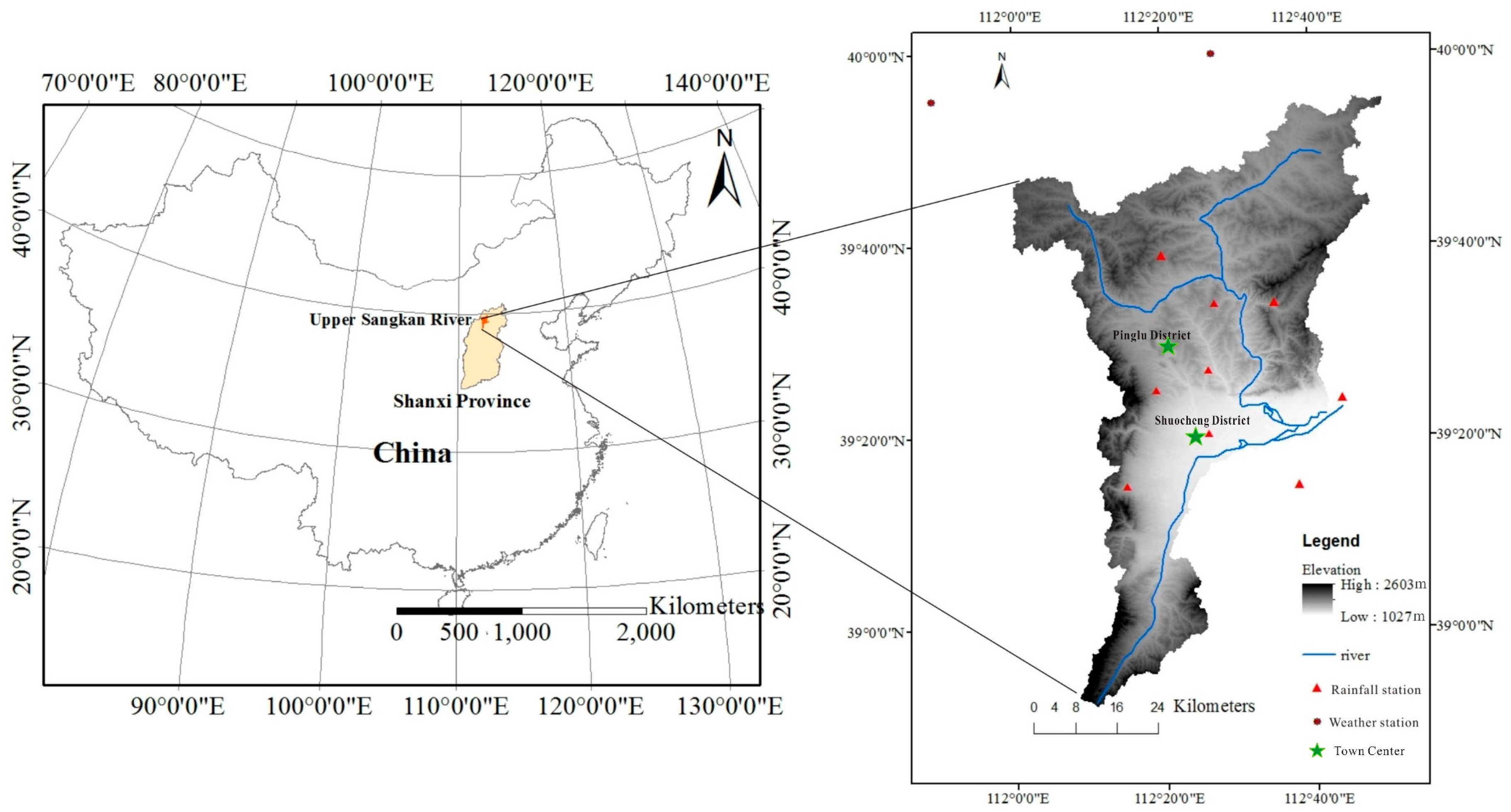

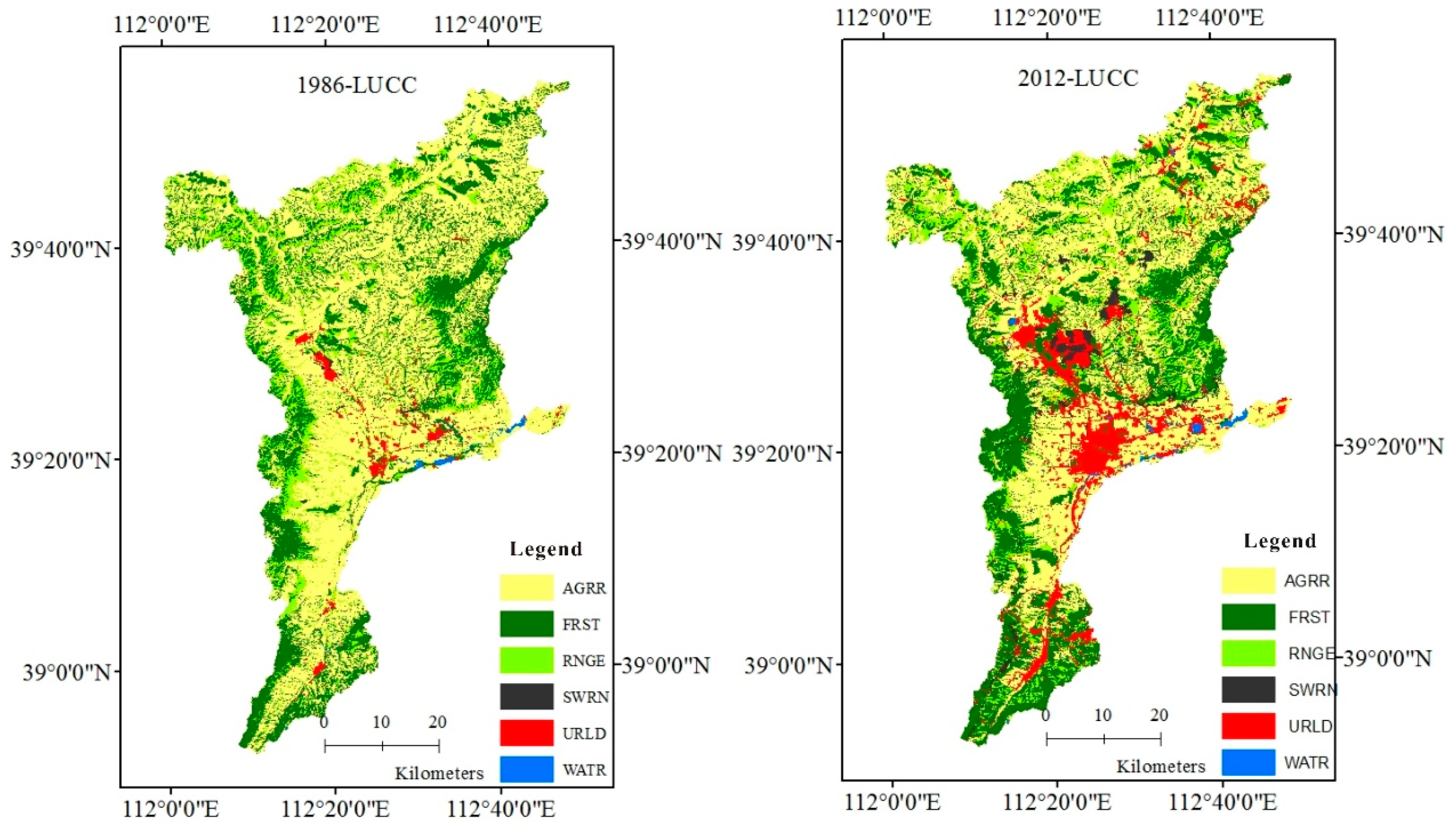
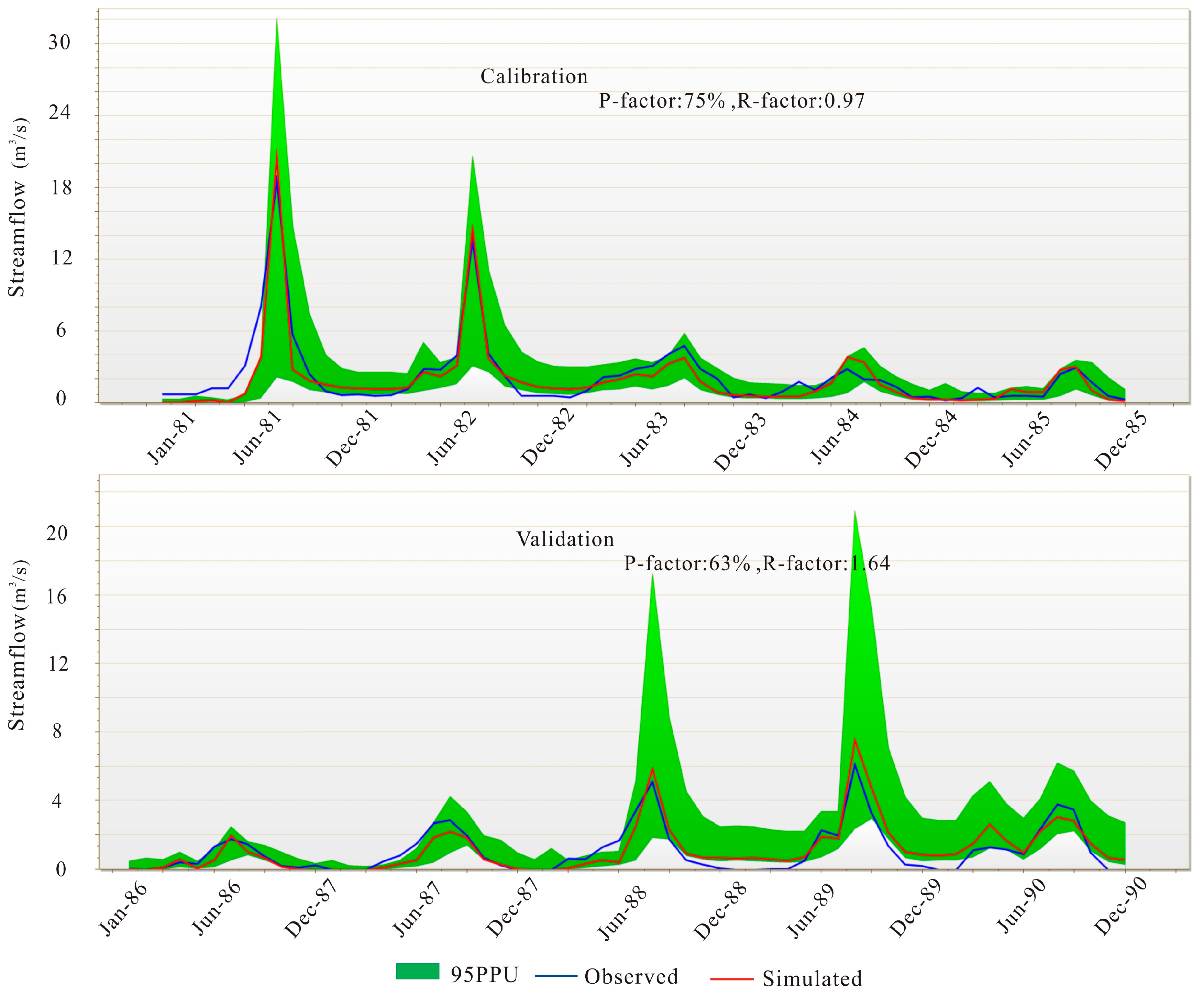
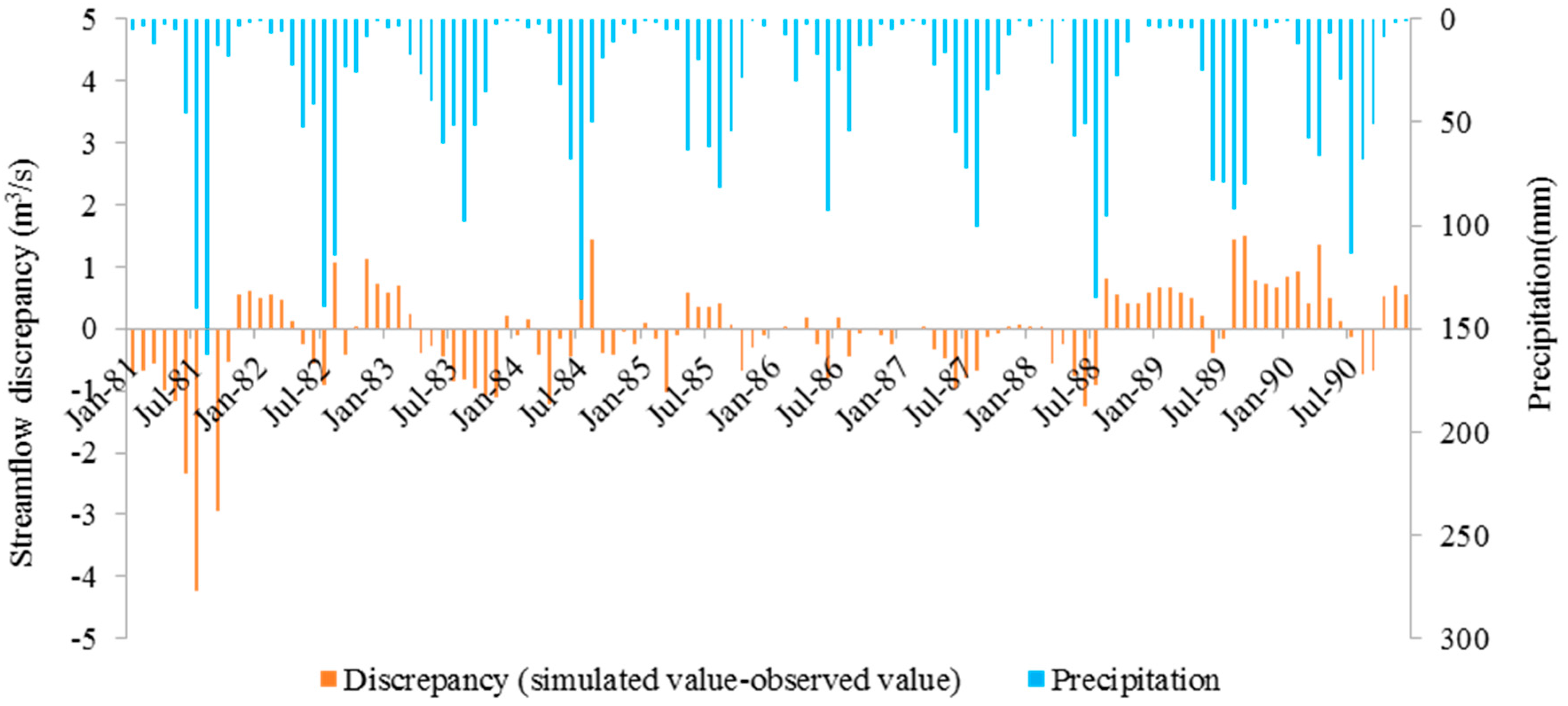



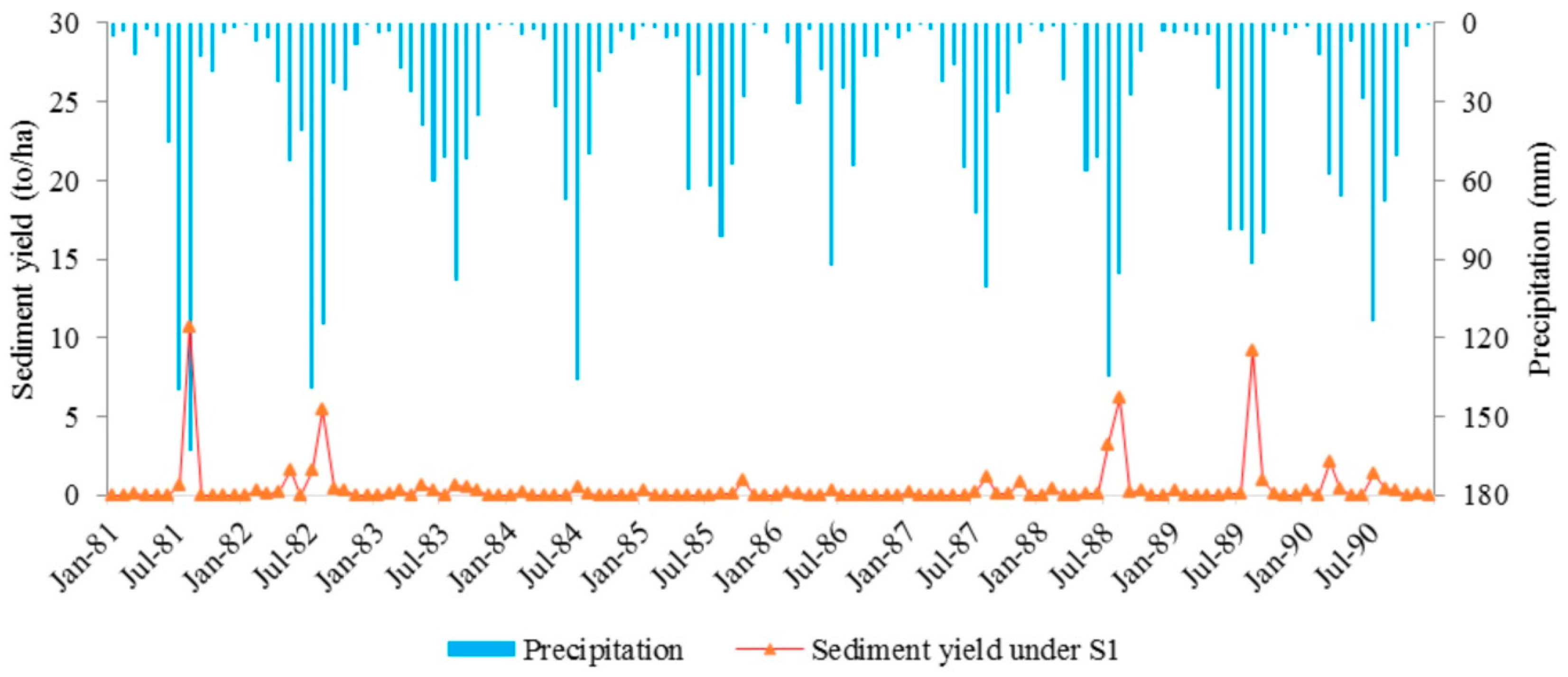
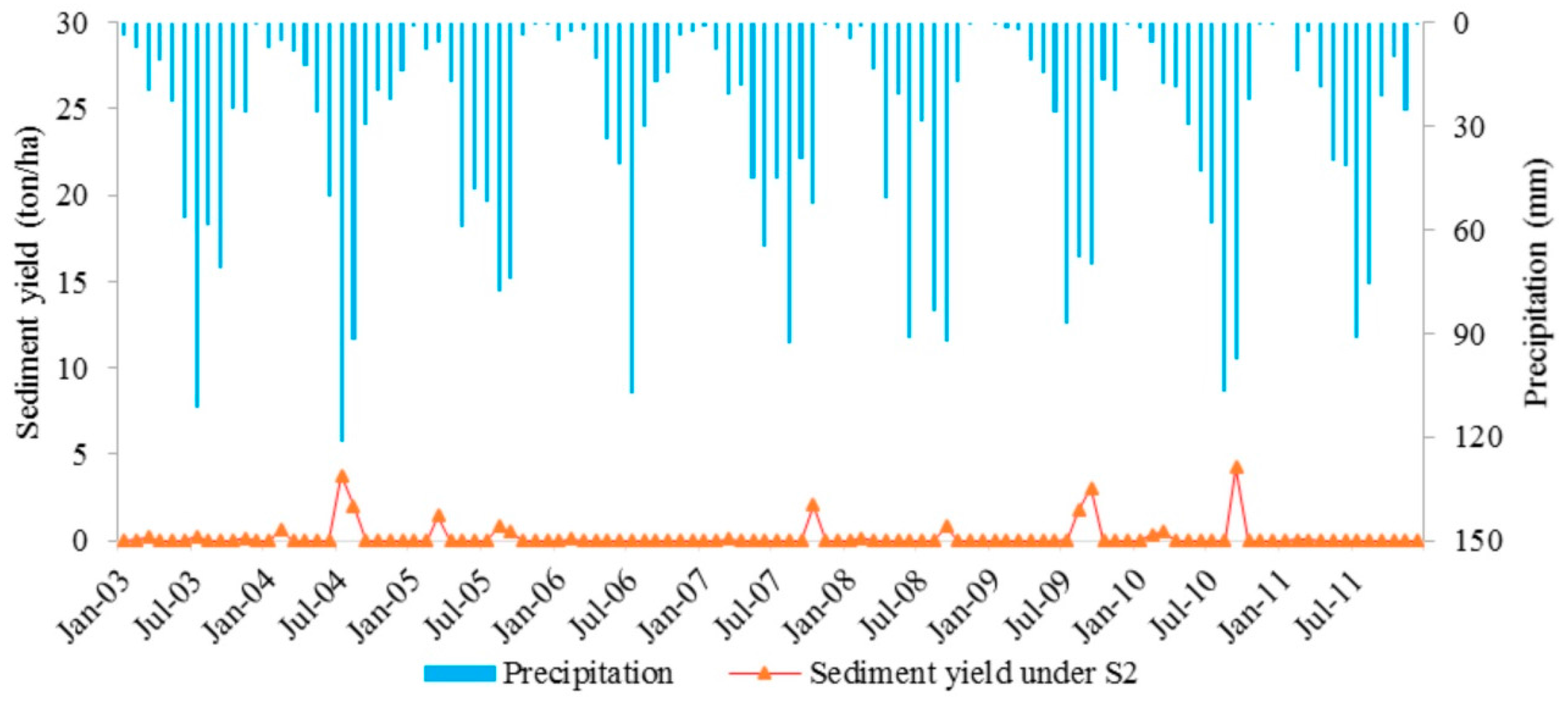
| Data Type | Data Format | Data Source | Application Modules | ||
|---|---|---|---|---|---|
| Spatial data | DEM | Grid | Geospatial Data Cloud | Runoff, interflow, Watershed delineation, river system generation | |
| Land use map | Grid/Shape | Interpreted from Landsat images via United States Geological Survey | Watershed subdivision, HRUs division | ||
| Soil map | Grid/Shape | Harmonized World Soil Database (HWSD) and China soil database | HRUs division, Soil database | ||
| Attribute data | Climate data | Precipitation | txt | China Water Year Book | Evapotranspiration, runoff |
| Maximum & minimum temperature, solar radiation, humidity, wind speed | txt | China Meteorological Data Sharing Service System; Global Weather Data for SWAT | |||
| Hydrological data | txt | China Water Year Book | Ground water, Model calibration and validation | ||
| Soil physical and chemical properties | DBF | HWSD and China soil database | Runoff, interflow | ||
| Land-Use Type | Meaning | SWAT Code |
|---|---|---|
| Agriculture land | Terrace land, Slope farmland, etc. | AGRR |
| Forest land | Shrub land, newly planted young forest, mixed forest of coniferous and broad-leaved forest, broad-leaved forest, protection forest for cultivated land, etc. | FRST |
| Grassland | Artificial grassland, grassland, protection grassland for cultivated land | RNGE |
| Unused land | Bare land, non-reclaimed mining dump land | SWRN |
| Building land | Village and urban construction land, roads, etc. | URLD |
| Water body | Reservoir, river, channel, etc. | WATR |
| Order | Parameters | Meaning | Best Parameters | t-Stat | p-Value |
|---|---|---|---|---|---|
| 1 | CN2 RO | Curve number | −7.36% r | 37.00 | 0.000 |
| 2 | USLE_C{2} SD | Min value of USLE C factor applicable to FRST | 0.44 | 17.31 | 0.000 |
| 3 | SLSUBBSN SD | Average slope length | 181.97 | 6.79 | 0.000 |
| 4 | SOL_AWC RO | Available water capacity of the soil layer | −20.36% r | −5.91 | 0.000 |
| 5 | REVAPMN RO | Threshold depth of water in the shallow aquifer for “revap” to occur (mm) | 326.5 | 1.86 | 0.064 |
| 6 | SPEXP SD | Exponent parameter for calculating sediment re-entrained in channel sediment routing | 1.18 | 1.65 | 0.098 |
| 7 | USLE_C{3} SD | Min value of USLE C factor applicable to RNGE | 0.38 | 1.64 | 0.101 |
| 8 | GW_DELAY SD | Groundwater delay (days) | 368.12 | 1.5 | 0.133 |
| 9 | CANMX RO | Maximum canopy storage | 13.23 | −1.47 | 0.141 |
| 10 | CH_COV1 SD | Channel erodibility factor | 0.34 | −1.33 | 0.184 |
| 11 | SPCON SD | Linear parameter for calculating the maximum amount of sediment that can be reentrained during channel sediment routing | 0.01 | −1.28 | 0.202 |
| 12 | GW_REVAP RO | Revap coefficient | 0.07 | −0.94 | 0.348 |
| 13 | ALPHA_BF RO | Base-flow recession constant | 0.46 | 0.86 | 0.392 |
| 14 | SOL_K RO | Saturated hydraulic conductivity (mm/h); | +19.78% r | 0.49 | 0.625 |
| 15 | CH_COV2 SD | Channel cover factor | 0.03 | −0.49 | 0.625 |
| 16 | CH_N2 RO | Manning’s “n” value for the main channel | 0.10 | 0.46 | 0.648 |
| 17 | EPCO RO | Plant uptake compensation factor | 0.51 | 0.42 | 0.675 |
| 18 | CH_ERODMO SD | Jan~Dec. channel erodability factor | 0.24 | −0.34 | 0.731 |
| 19 | ESCO RO | Soil evaporation compensation coefficient | 0.24 | 0.28 | 0.778 |
| 20 | RCHRG_DP RO | Deep aquifer percolation fraction | 0.59 | 0.27 | 0.786 |
| 21 | CH_K2 RO | Effective hydraulic conductivity in main channel (mm/h) | 174.49 | 0.20 | 0.841 |
| 22 | USLE_C{1} SD | Min value of USLE C factor applicable to AGRR | 0.05 | −0.195 | 0.84 |
| 23 | GWQMN RO | Treshold depth of water in the shallow aquifer required for return flow to occur (mm). | 580.48 | 0.03 | 0.973 |
| Soil Erosion Grades | Soil Erosion Modulus | The Sub-Basins of HRUs Locating | Area (km2) | ||||
|---|---|---|---|---|---|---|---|
| FRST | RNGE | AGRR | Total | ||||
| Extreme | >150 t ha−1 yr−1 | 18, 19 | 34.6 | 10.4 | 0 | 45 | |
| severe | 80–150 t ha−1 yr−1 | 7–9, 19, 21 | 12 | 3 | 0 | 15 | |
| strong | 50–80 t ha−1 yr−1 | 4, 7–9, 18–21 | 53.3 | 47.2 | 0 | 100 | |
| moderate | 25–50 t ha−1 yr−1 | 3, 4, 6–9, 12, 17–21 | 94.7 | 64.9 | 0 | 159.7 | |
| low | 10–25 t ha−1 yr−1 | 2–9, 11–13, 17–21 | 180.6 | 99.3 | 64.4 | 344.3 | |
| slight | slight-III | 10–5 t ha−1 yr−1 | 1–9, 11–13, 17, 18, 19–21 | 283.2 | 105.8 | 236.5 | 625.5 |
| slight-II | 2–5 t ha−1 yr−1 | 1–3, 6–17, 19–21 | 44.84 | 64 | 559.1 | 667.9 | |
| slight-I | <2 t ha−1 yr−1 | 1–21 | 257.4 | 96.9 | 1090 | 1444 | |
| Sub-Basin | Land Use 1986 under S0 | Land Use 2012 under S1 | ||||||||||
|---|---|---|---|---|---|---|---|---|---|---|---|---|
| AGRR | FRST | RNGE | SWRN | URLD | WATR | AGRR | FRST | RNGE | SWRN | URLD | WATR | |
| 1 | −1 | - | ||||||||||
| 2 | −1 | - | - | |||||||||
| 3 | −1 | +1 | ||||||||||
| 4 | −1 | - | ||||||||||
| 5 | −1 | −1 | - | |||||||||
| 6 | −1 | +1 | ||||||||||
| 7 | −1 | +1 | - | |||||||||
| 8 | −1 | |||||||||||
| 9 | +1 | |||||||||||
| 10 | −1 | - | - | |||||||||
| 11 | - | - | ||||||||||
| 12 | +1 | +1 | - | - | ||||||||
| 13 | +2 | +1 | - | - | ||||||||
| 14 | ||||||||||||
| 15 | −1 | - | ||||||||||
| 16 | +1 | - | ||||||||||
| 17 | +1 | - | ||||||||||
| 18 | +1 | |||||||||||
| 19 | +1 | |||||||||||
| 20 | −1 | −1 | - | |||||||||
| 21 | −1 | −1 | - | |||||||||
 ” means the severe soil erosion level, “
” means the severe soil erosion level, “  ” means the strong soil erosion level, ”
” means the strong soil erosion level, ”  ” means the moderate soil erosion level, “
” means the moderate soil erosion level, “  ” means the low soil erosion level, “
” means the low soil erosion level, “  ” means the slight soil erosion level; in the right part of the table, the data of “+1” and “+2” mean the soil erosion level increased by one or two level comparing with that of 1986, while “−1” means the soil erosion level decreased by one level. “-” means new land use types with no comparison.
” means the slight soil erosion level; in the right part of the table, the data of “+1” and “+2” mean the soil erosion level increased by one or two level comparing with that of 1986, while “−1” means the soil erosion level decreased by one level. “-” means new land use types with no comparison.| Soil Erosion Grades | Soil Erosion Modulus | The Sub-Basins of HRUs Locating | Area (km2) | ||||
|---|---|---|---|---|---|---|---|
| FRST | RNGE | AGRR | Total | ||||
| Extreme | >150 t ha−1 yr−1 | - | 0 | 0 | 0 | 0 | |
| severe | 80–150 t ha−1 yr−1 | 19 | 92.3 | 232.9 | 0 | 325.1 | |
| strong | 50–80 t ha−1 yr−1 | 18, 19 | 119.3 | 267.1 | 0 | 386.4 | |
| moderate | 25–50 t ha−1 yr−1 | 3, 6, 8, 18, 19, 21 | 396.7 | 446.2 | 0 | 842.9 | |
| low | 10–25 t ha−1 yr−1 | 3–9, 18–21 | 248.5 | 455.2 | 0 | 703.7 | |
| slight | slight-III | 10–5 t ha−1 yr−1 | 1–9, 11–13, 17, 18, 19–21 | 196.1 | 110.3 | 37.5 | 343.9 |
| slight-II | 2–5 t ha−1 yr−1 | 1–3, 6–17, 19–21 | 100.1 | 66.3 | 120.8 | 287.2 | |
| slight-I | <2 t ha−1 yr−1 | 1–21 | 35.9 | 12.2 | 44.5 | 92.6 | |
| Sub-Basin | AGRR Area (km2) | FRST Area (km2) | RNGE Area (km2) | SWRN Area (km2) | URLD Area (km2) | WATR Area (km2) | SYLD Change Rate (t ha−1 yr−1) | Erosion Rate Decrease Order |
|---|---|---|---|---|---|---|---|---|
| 1 | −55.7 | 2.0 | 52.8 | 0.0 | 0.0 | 0.0 | 0.7 | 21 |
| 2 | −17.6 | −9.9 | 10.8 | 0.0 | 13.6 | 0.0 | −0.8 | 12 |
| 3 | 3.2 | −16.1 | 13.4 | 0.0 | 0.0 | 0.0 | 0.2 | 18 |
| 4 | −10.9 | −8.9 | 20.2 | 0.0 | 0.0 | 0.0 | −3.7 | 8 |
| 5 | −2.2 | −0.8 | 3.0 | 0.0 | 0.0 | 0.0 | 0.5 | 20 |
| 6 | −11.1 | 0.5 | 10.6 | 0.0 | 0.0 | 0.0 | −0.4 | 14 |
| 7 | −13.5 | −1.1 | 3.8 | 11.2 | 0.0 | 0.0 | −6.1 | 6 |
| 8 | −8 | 3.1 | 4.9 | 0.0 | 0.0 | 0.0 | −9.1 | 5 |
| 9 | −17.9 | 13.6 | 4.9 | 0.0 | 0.0 | 0.0 | −12.0 | 3 |
| 10 | −43.8 | 4.6 | 0.73 | 16.1 | 22.9 | 0.0 | 0.4 | 19 |
| 11 | −73.4 | 22.5 | −14 | 20.8 | 44.4 | 0.0 | −1.1 | 11 |
| 12 | −17.6 | 32.5 | −33.8 | 0.0 | 19.1 | 0.0 | −2.1 | 10 |
| 13 | −4.8 | −1 | −30.8 | 0.0 | 37.0 | 0.0 | −2.7 | 9 |
| 14 | −0.4 | 0.0 | 0.0 | 0.0 | 0.0 | 0.3 | 0.01 | 15 |
| 15 | −33.3 | 8.7 | 0.0 | 0.0 | 24.9 | 0.0 | 0.2 | 17 |
| 16 | 0.3 | −2.9 | 0.0 | 0.0 | 6.5 | −3.9 | 0.1 | 16 |
| 17 | −10.8 | −10.3 | −7.7 | 0.0 | 28.9 | 0.0 | −0.5 | 13 |
| 18 | 4.1 | 8.0 | −12.1 | 0.0 | 0.0 | 0.0 | −44.5 | 1 |
| 19 | −19.3 | 32.1 | −12.4 | 0.0 | 0.0 | 0.0 | −25.2 | 2 |
| 20 | −46.6 | 23.5 | 0.5 | 0.0 | 22.6 | 0.0 | −5.9 | 7 |
| 21 | −46.9 | 22.3 | 24.4 | 0.0 | 0.0 | 0.0 | −10.8 | 4 |
| Total | −426.2 | 122.7 | 39.2 | 48.0 | 219.9 | −3.5 | −5.5 |
| Sub-Basin | SYLD (t ha−1 yr−1) | Sub-Basin | SYLD (t ha−1 yr−1) | ||||
|---|---|---|---|---|---|---|---|
| Scenario 0 | Scenario 1 | Scenario 2 | Scenario 0 | Scenario 1 | Scenario 2 | ||
| 1 | 1.6 | 2.3 | 0.6 | 12 | 2.9 | 0.9 | 0.3 |
| 2 | 3.5 | 2.7 | 0.9 | 13 | 3.5 | 0.8 | 0.4 |
| 3 | 5.7 | 5.9 | 2 | 14 | 0.03 | 0.04 | 0.02 |
| 4 | 9.7 | 6 | 2.5 | 15 | 0.6 | 0.7 | 0.5 |
| 5 | 4.5 | 5 | 2.3 | 16 | 0.05 | 0.1 | 0.1 |
| 6 | 5.6 | 5.2 | 1.5 | 17 | 0.1 | 0.5 | 0.4 |
| 7 | 11 | 4.9 | 2.1 | 18 | 60.7 | 16.2 | 2.8 |
| 8 | 16.2 | 7 | 3.1 | 19 | 41.9 | 16.7 | 3.5 |
| 9 | 19.3 | 7.3 | 5.1 | 20 | 11.7 | 5.8 | 8 |
| 10 | 1 | 1.4 | 0.6 | 21 | 21.3 | 10.5 | 15.7 |
| 11 | 2.1 | 1.1 | 0.5 | Average | 11.1 | 5.6 | 2.6 |
© 2017 by the authors. Licensee MDPI, Basel, Switzerland. This article is an open access article distributed under the terms and conditions of the Creative Commons Attribution (CC BY) license (http://creativecommons.org/licenses/by/4.0/).
Share and Cite
Zhang, L.; Karthikeyan, R.; Zhang, H.; Tang, Y. Estimation of Sediment Yield Change in a Loess Plateau Basin, China. Water 2017, 9, 683. https://doi.org/10.3390/w9090683
Zhang L, Karthikeyan R, Zhang H, Tang Y. Estimation of Sediment Yield Change in a Loess Plateau Basin, China. Water. 2017; 9(9):683. https://doi.org/10.3390/w9090683
Chicago/Turabian StyleZhang, Ling, Raghupathy Karthikeyan, Hui Zhang, and Yuxuan Tang. 2017. "Estimation of Sediment Yield Change in a Loess Plateau Basin, China" Water 9, no. 9: 683. https://doi.org/10.3390/w9090683
APA StyleZhang, L., Karthikeyan, R., Zhang, H., & Tang, Y. (2017). Estimation of Sediment Yield Change in a Loess Plateau Basin, China. Water, 9(9), 683. https://doi.org/10.3390/w9090683





